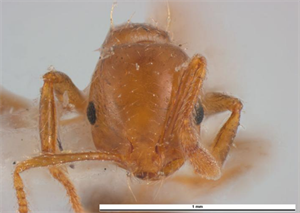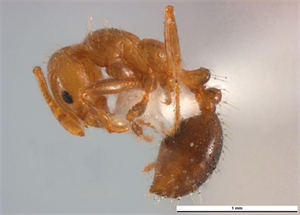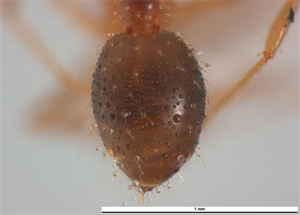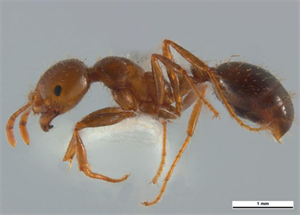Red imported fire ant
Pacific Pests, Pathogens, Weeds & Pesticides - Online edition
Pacific Pests, Pathogens, Weeds & Pesticides
Red imported fire ant (363)
Solenopsis invicta
Particularly in hot arid regions. Asia, Africa, North, South and Central America, the Caribbean, Oceania. It is recorded from Australia (Queensland), where it is under eradication. It has been eradicated from New Zealand.
An ant that favours disturbed, sunny habitats, agricultural and plantation forest areas - deforested areas are particularly susceptible to colonisation. It can establish in urban areas, lawns, gardens, parks, golf courses, and in walls of houses. Seeds and/or seedlings of the following are collected, attacked, or pollination is prevented: bean, cabbage, citrus, cucumber, eggplant, maize, okra, peanut, potato, sorghum, soybean, sunflower, and sweetpotato.
An aggressive, invasive ant that becomes the dominant species wherever it occurs. It is similar to the tropical fire ant, except that it is more aggressive, and the sting is more painful, which may cause a severe allergic reaction.
The ant is similar to the tropical fire ant with overlap in colour, size and shape. Workers are reddish-brown with a brown or black gaster (Photos 3&6). There are two types of workers, varying between 3-6 mm long. The 'minor' workers tend the brood (Photo 1-3), whereas 'major' workers, the soldiers, forage for food (Photos 4-6). Apart from workers, fertile females and males are produced. Males are completely black. Queens are up to 9 mm long. It is similar to the tropical fire ant with overlap in colour, size and shape.
Nests vary in size and shape; they may be mounds up to 40 cm high and 30-50 cm diameter, or small, flat patches of soil. There are no obvious entrance holes: these are 5-10 metres away. Below ground, there are interconnecting galleries 30-40 cm deep, deeper in dry times. Colonies may have between 200 and 400 thousand individuals.
Nests are of two kinds: one type has a single queen, the other has two or more. Where there is more than a single queen, territorial behaviour is absent. In this case, there may be up to 500 nests per hectare, 10 times more than areas where nests have single queens.
Food is varied. Seeds are collected and stored. Honeydew from aphids, scale, mealybugs and whiteflies is collected, and the ant is an important predator of other insects, and small vertebrates.
Spread occurs by fertile queens establishing a new nest after a mating flight, or it occurs by 'budding' - a queen will move out with a few workers and establish a nest nearby. Spread also occurs over long distances in the soil of potted plants, and even in soil-infested wooden pallets. The ants are known to link together to form floating 'rafts' to survive periods of flooding.
Solenopsis invicta is known as a 'tramp' ant. These are ants that have become widely distributed globally associated with increased trade and commerce. A specialist group of the International Union for Conservation of Nature says the following about the red imported fire ant: "Solenopsis invicta is highly invasive because of its high reproductive capacity, large colony size, ability to exploit human disturbances, wide food range and ability to sting. Its stinging ability allows it to subdue prey, and even repel larger vertebrate competitors from resources".
The impact on agriculture needs a special mention. Seeds are collected, fruits attacked, and new shoots and roots damaged, reducing yields; sap-sucking insects are protected from their natural enemies encouraging population explosions of pest species; and the ants' painful sting makes field work difficult.
The red imported fire ant currently occupies 128 million hectares in nine south-eastern states in the USA. Its impact is huge, more than a billion dollars a year. Losses occur when the ant interferes with the root systems of plants, prevents combine harvesting and attacks young plants. In 1990, estimates of loss in soybean were put at $150 million. Each year in the USA, the infested states spend many hundreds of millions of dollars on attempts to manage the red imported fire ant, and households spend considerable sums on pesticides. In Australia, ABARE, the Australian Bureau of Agriculture and Resource Economics, estimates that rural industries have sustained losses of $30 billion over 30 years due to the ant.
A report in 2021 predicts that should the red imported fire ant be introduced to Pacific island countries the economic, biodiversity, and social impacts would be considerable, over USD329 annually, or 0.7% of combined GDP, with half the burden carried by agriculture.
According to PIAT (Pacific Invasive Ant Toolkit), this ant is one of the five worst ants, together with the little fire ant, the big-headed ant, the yellow crazy ant, and the Argentine ant (http://www.piat.org.nz/problem-ants/worst-5-identification). It is also among 100 of the World's Worst Invasive Alien Species, published by The Invasive Species Specialist Group (ISSG), a specialist group of the Species Survival Commission of the World Conservation Union. (http://www.issg.org/pdf/publications/worst_100/english_100_worst.pdf).
Look for reddish-brown ants, and mounds of soil, larger in pastures than lawns, but without openings. However, separation to species needs the assistance of a taxonomist familiar with the Solenopsis group.
The PIAkey provides charts with three similar Solenopsis species - geminata, invicta and papuana, plus Monmorium species - side-by-side for comparisons of important taxonomic features. (http://idtools.org/id/ants/pia/Fact_Sheets/Solenopsis_geminata.html). The feature on the head that distinguishes invicta from geminata is shown.
The app: Antkey Mobile: an identification key for introduced ants. USDA. LUCID, is useful for preliminary examinations, as is the online version: (http://idtools.org/id/ants/pia/PIAkey_v2.html).
The Pacific Invasive Ants Taxonomy Workshop manual has a key to the Pacific species and is well illustrated (http://www.issg.org/cii/Electronic%20references/pii/project_docs/papp/pacific_ants_taxonomy_workshop_2009.pdf).
QUARANTINE
Countries that are still free from, but vulnerable to the red imported ant, need to: (i) define the risk; (ii) have preventive measures in place against an introduction; (iii) have quarantine protocols enacted in case a breach occurs; and (iv) be able to carry out a rapid response against this ant and others. It is important to have rapid response procedures in place in case eradication is a possibility. In addition, it is necessary to have biosecurity regulations to prevent movement of the ant within the country, especially in Pacific island countries where most are island groups or archipelagos. Finally, monitoring is required on the islands still free from infestation.
A Pacific Ant Prevention Plan has been written on behalf of the IUCN/SSC Invasive Species Specialist Group and presented to the Pacific Plant Protection Organisation and Regional Technical Meeting for Plant Protection (2004). Solenopsis invicta is one of the 11 species covered. (http://issg.org/database/species/reference_files/PAPP.pdf). The Plan focuses on ways to prevent the introduction, establishment and spread of this ant.
Guidelines to assist Pacific island countries and territories in planning effective management of invasive species have also been prepared by the Pacific Community and the Secretariat of the Pacific Regional Environment Programme. (http://www.piat.org.nz/uploads/PIAT_content/pdfs/SPREP%20guidelines%20for%20invasive%20species%20management%20in%20the%20Pacific.pdf).
The IUCN/SSC Invasive Species Specialist Group website should be consulted for details on all aspects of eradication and management of invasive ants (http://www.issg.org/).
NATURAL ENEMIES
In the USA, several species of Pseudacteon parasitic (phorid) flies have been introduced and are under study. They were introduced from Argentina and brazil.
CULTURAL CONTROL
Hot water at 47°C (and above) kills ants. Hot water up to 49°C will not damage plants. A more extreme method is to use fire to destroy the nests and to create conditions that favour native ant species.
CHEMICAL CONTROL
In general, three types of chemicals are used against ants: (i) stomach poisons. e.g., Maxforce® (fipronil), Amdro® (hydramethylnon), and borax; (ii) insect growth regulators (e.g., Engage® (methoprene), and Distance® (pyriproxyfen); and (iii) poisons that work on the nervous system, that is, neurotoxins, e.g., bifenthrin, fipronil, and imidacloprid. Stomach poisons kill all queens, intercastes and workers; insect growth regulators stop the queens from laying eggs, whereas neurotoxins disrupt insects' central nervous system. It is likely that future products will combine toxins that cause rapid death and insect growth regulators, e.g., Extinguish Plus® (hydramethylnon and methoprene).
A note of caution: Although it is possible to combine a lure (such as peanut butter, fish, sugar, etc.) with a pesticide as an ant bait, it is not recommended because of the danger in leaving concentrated pesticides unattended in the environment, including dwellings.
Treatment options (and case studies) are provided in the Pacific Invasive Ant Toolkit under (http://piat.org.nz/getting-rid-of-ants).
____________________
When using a pesticide, always wear protective clothing and follow the instructions on the product label, such as dosage, timing of application, and pre-harvest interval. Recommendations will vary with the crop and system of cultivation. Expert advice on the most appropriate pesticide to use should always be sought from local agricultural authorities.
AUTHOR Grahame Jackson
Information from CABI (2017) Solenopsis invicta (red imported fire ant). Crop Protection Compendium (https://www.cabi.org/cpc/datasheet/50569); and Pacific Invasive Ant Toolkit. (http://piat.org.nz/); and Solenopsis invicta. AntWiki. (http://www.antwiki.org/wiki/Solenopsis_invicta); and AntWeb. (https://www.antweb.org/description.do?genus=solenopsis&species=invicta&rank=species&resetProject=true); and Solenopsis invicta (2018) Global Invasive Species Database. (http://www.iucngisd.org/gisd/species.php?sc=77); and from Gruber AM, et al. (2021) Predicting socio-economic and biodiversity impacts of invasive species: Red imported fire ant in the developing western Pacific. Ecological Management & Restoration 22(1): 89-99. (https://onlinelibrary.wiley.com/doi/full/10.1111/emr.12457). Photos 1-6 Amy Carmichael (2005) Red imported fire ant (Solenopsis invicta). Queensland University of Technology. PaDIL - (https://www.padil.gov.au/).
Produced with support from the Australian Centre for International Agricultural Research under project HORT/2016/185: Responding to emerging pest and disease threats to horticulture in the Pacific islands, implemented by the University of Queensland and the Secretariat of the Pacific Community.









